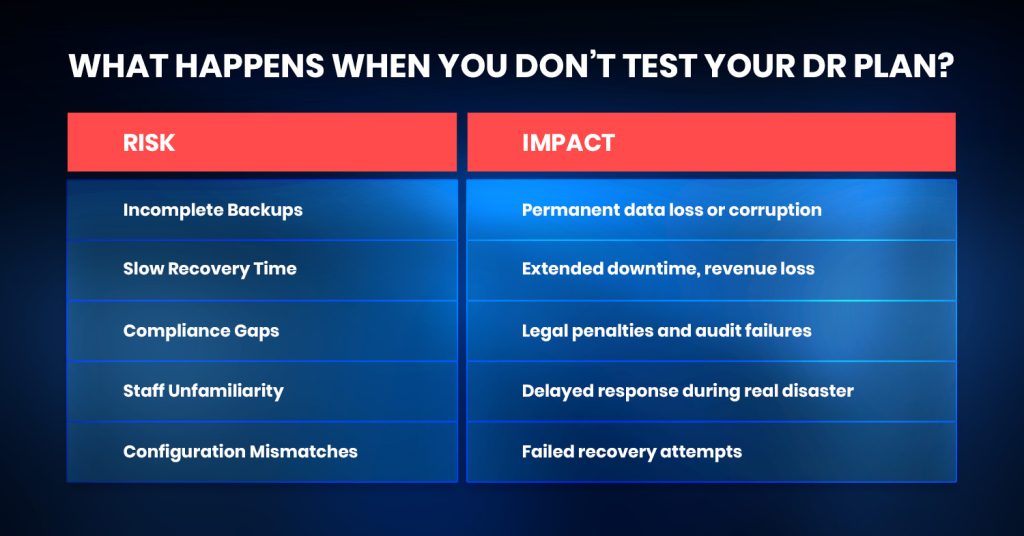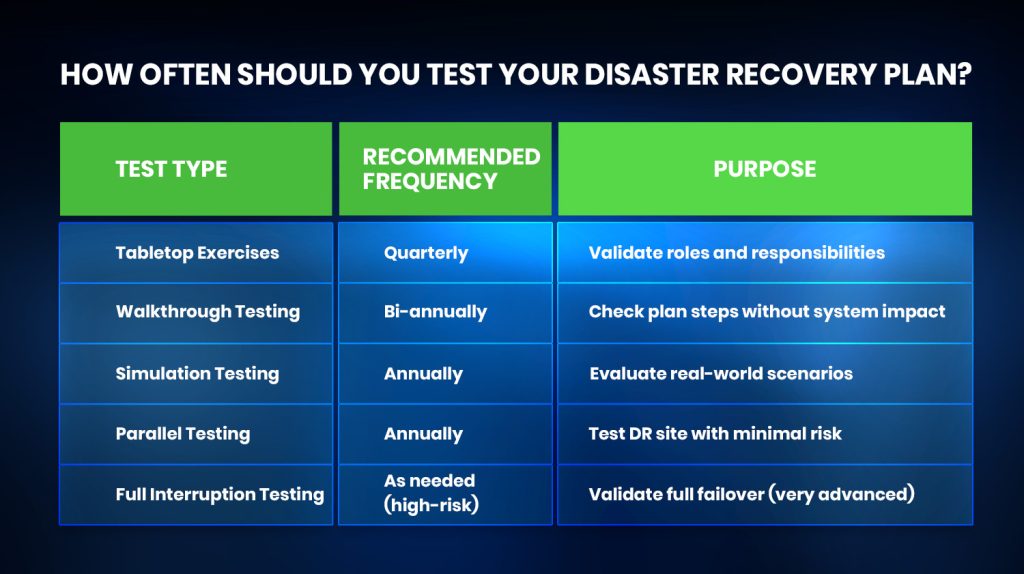When Was the Last Time You Tested Your DR Plan?

Business continuity is the key purpose for companies looking to grow in this quickly changing digital economy. Disaster recovery (DR) testing, however, is one of the most overlooked aspects of an effective continuity plan. Organizations often invest in disaster recovery services or even comprehensive DRaaS solutions but forget the most critical step, which is regular testing of their DR plans.
So, when was the last time you actually tested your DR plan? If you have to think too hard about that, your business could already be at risk.
Why Does Disaster Recovery Testing Matter So Much?
Disaster recovery is not a “set it and forget it” task. It’s a continuous process that changes as your applications, employees, infrastructure, and threats do. Your disaster recovery strategy can appear excellent on paper, but you won’t know how well it works when an actual disaster strikes until testing is done.
Testing helps you identify:
- Gaps in documentation
- Configuration mismatches
- Changes in application dependencies
- Staff readiness and training levels
- Hardware and software compatibility issues
Simply put, a disaster recovery plan that has not been tested is as risky as not having one at all.
What Can Go Wrong Without Regular Testing?
Many companies believe they are safe if they have backups. The disturbing fact is that backups are only a single component of disaster recovery.

Without testing, you might face:
- Data loss: Backups that are damaged or incomplete could go undetected.
- Excessive downtime: Unexpected bottlenecks may cause recovery procedures to take too long.
- Violations of compliance: Documented DR testing is required by many regulatory standards.
- Customer dissatisfaction: Service interruptions undermine confidence and harm your reputation.
These risks can often be reduced by routinely verifying your disaster recovery services and ensuring your team is well-versed in execution.
What Does an Effective DR Test Look Like?
The choice between the various DR testing levels is based on the level of experience and risk tolerance of your company:
Tabletop Exercises
Teams go through the DR plan step-by-step in a meeting-based scenario. This method helps define jobs and responsibilities and is low-risk.
Walkthrough Testing
Teams thoroughly review each DR plan element in this scenario without initiating failovers.
Simulation Testing
You use a test environment to mimic a real-world crisis. This is one of the most insightful exams for both internal teams and disaster recovery service providers.
Parallel Testing
While the primary system is operational, you replicate systems at the disaster recovery location. This allows you to test with little effect on operations.
Full Interruption Testing
The most daring test is shutting down production systems to test failover methods. Although this method is infrequently utilized, it is effective for businesses that need to ensure uptime.
How Often Should You Test Your DR Plan?

Best practices suggest testing:
- Annually, for complete DR tests
- Quarterly for partial or component testing
- Post-major changes such as infrastructure upgrades, new applications, or significant staffing changes
DRaaS systems enable more frequent testing with automation tools and cloud-based simulations.
How Can DRaaS Simplify Testing?
Disaster Recovery as a Service (DRaaS) has completely changed how businesses test DR. In contrast with traditional on-premise DR configurations, DRaaS platforms provide:
- Automated testing capabilities
- Centralized dashboards and reporting
- Version control and change tracking
- Compliance readiness with audit trails
With many modern DRaaS solutions, you can test in cloned environments without interfering with production. This boosts trust in recovery readiness while assisting companies in meeting compliance standards.
The Cost of Skipping a Test
Consider a financial services firm with a well-funded, highly detailed DR plan. When ransomware hit their servers, they discovered
- Their last backup was 12 days old
- Recovery processes had changed due to a recent server upgrade
- The IT team was unfamiliar with new failover tools
They lost over $2 million in downtime and penalties.
A single round of testing would have flagged these issues.
What Role Do Disaster Recovery Service Providers Play?
Skilled disaster recovery service providers help businesses with planning, testing, and optimization while providing infrastructure. Working with a company that provides managed DRaaS solutions guarantees confidence and continuity. They help.
- Create customized testing schedules
- Train teams on DR tools and processes
- Provide reports and insights to fine-tune your strategy
- Ensure compliance with industry standards like ISO 22301, GDPR, or HIPAA
What Should You Review During Testing?
To maximize the value of your test, ask the following checklist:
Are your RTO (Recovery Time Objective) and RPO (Recovery Point Objective) realistic and met during the test?
- Did all systems and applications recover as expected?
- Were backup files intact, recent, and uncorrupted?
- Did the team follow the recovery protocol without confusion?
- Were communication channels (internal and external) effective?
- Were any compliance gaps discovered?
Test Now or Pay Later
Disaster recovery services invest in resilience, but they only deliver value if tested and proven. Whether you rely on in-house infrastructure or advanced DRaaS solutions, routine testing must be part of your operational rhythm. For your enterprise DR challenges, ESDS provides the proper solution.
With its reliable, automated, and completely managed Disaster Recovery (DR) services, ESDS makes conducting thorough DR testing that complies with legal and industry standards easier. ESDS ensures that failover and failback methods work by modeling real-world disaster scenarios across on-premise, cloud, and hybrid infrastructures. In order to ensure the least disruption and maximum uptime in the event of unforeseen disasters, these quarterly drills assist firms in validating their Recovery Time Objectives (RTOs) and Recovery Point Objectives (RPOs), improving compliance readiness, and building overall company resilience.
“ESDS Software Solution Limited is proposing, subject to receipt of requisite approvals, market conditions and other considerations, to make an initial public offer of its equity shares and has filed a draft red herring prospectus (“DRHP”) with the Securities and Exchange Board of India (“SEBI”) that is available on the website of the Company at https://www.esds.co.in/, the website of SEBI at www.sebi.gov.in as well as on the websites of the book running lead managers, DAM Capital Advisors Limited at https://www.damcapital.in/ and Systematix Corporate Services Limited at http://www.systematixgroup.in/ The website of the National Stock Exchange of India Limited at www.nseindia.com and the website of the BSE Limited at www.bseindia.com, respectively. Investors should note that investment in equity shares involves a high degree of risk. For details, potential investors should refer to the RHP, which may be filed with the Registrar of Companies, Maharashtra, at Mumbai, in the future, including the section titled “Risk Factors”. Potential investors should not rely on the DRHP filed with SEBI in making any investment decision.”
- Achieving Secure, Reliable Compliance with India’s Data Sovereignty Mandates - November 17, 2025
- Implementing GPU workloads in critical government application - November 12, 2025
- Why Data Sovereignty Is Important for Indian Enterprises - August 22, 2025
